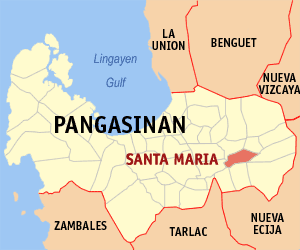Santa Maria, Pangasinan
Appearance
| Santa Maria | |
|---|---|
| Baley na Filipinas | |
 | |
 Lokasyon na Santa Maria | |
 | |
| 15°58′51″N 120°42′1″E | |
| Dalin | Filipinas |
| Barangay | 23 |
| Kaawang | |
| • Katiponan | 69.50 km2 (26.83 sq mi) |
| Elebasyon | 45 m (148 ft) |
| Bilang na too (Mayo 1, 2020)[1] | |
| • Katiponan | 34,220 |
| • Densidad | 490/km2 (1,300/sq mi) |
| Economia | |
| • Clase | kumapat ya klase ya baley |
| • Ingresos | ₱134,288,269.22 (2020) |
| • Activos | ₱356,452,922.78 (2020) |
| • Pasivos | ₱25,269,202.22 (2020) |
| • Gastos | ₱122,504,624.72 (2020) |
| Kodigo na postal | 2440 |
| Kodigo na lugar | 75 |
| Website |
www |
Say Santa Maria et kumapat ya klase ya baley ed luyag na Pangasinan, Filipinas. Unong ed 1 Mayo 2020 census, say populasyon to et 34,220 totoo tan 8,249 abong. Walay kabaleg tan sukat to ya 69.50 sq. km. Say zip code to et 2440.
Saray barangay
[dumaen | dumaen so pinanlapuan]- Bal-loy
- Bantog
- Caboluan
- Cal-litang
- Capandanan
- Cauplasan
- Dalayap
- Libsong
- Namagbagan
- Paitan
- Pataquid
- Pilar
- Poblacion East
- Poblacion West
- Pugot
- Samon
- San Alejandro
- San Mariano
- San Pablo
- San Patricio
- San Vicente
- Santa Cruz
- Santa Rosa
Demograpiko
[dumaen | dumaen so pinanlapuan]| Taon | Pop. | ±% p.a. |
|---|---|---|
| 1903 | 7,628 | — |
| 1918 | 7,362 | −0.24% |
| 1939 | 10,295 | +1.61% |
| 1948 | 12,802 | +2.45% |
| 1960 | 14,230 | +0.89% |
| 1970 | 16,296 | +1.36% |
| 1975 | 18,766 | +2.87% |
| 1980 | 19,018 | +0.27% |
| 1990 | 23,793 | +2.27% |
| 1995 | 25,278 | +1.14% |
| 2000 | 27,860 | +2.11% |
| 2007 | 30,721 | +1.36% |
| 2010 | 31,091 | +0.44% |
| 2015 | 33,038 | +1.16% |
| 2020 | 34,220 | +0.69% |
| Reperensiya: Philippine Statistics Authority[2][3][4] | ||
Saray reperensiya
[dumaen | dumaen so pinanlapuan]- ↑ "2020 Census of Population and Housing (2020 CPH) Population Counts Declared Official by the President". Hulyo 7, 2021. https://psa.gov.ph/content/2020-census-population-and-housing-2020-cph-population-counts-declared-official-president.
- ↑ Census of Population (2015). "Region I (Ilocos Region)". Total Population by Province, City, Municipality and Barangay. PSA. Retrieved 29 June 2016.
- ↑ Census of Population and Housing (2010). "Region I (Ilocos Region)". Total Population by Province, City, Municipality and Barangay. NSO. Retrieved 29 June 2016.
- ↑ Censuses of Population (1903–2007). "Region I (Ilocos Region)". Table 1. Population Enumerated in Various Censuses by Province/Highly Urbanized City: 1903 to 2007. NSO.